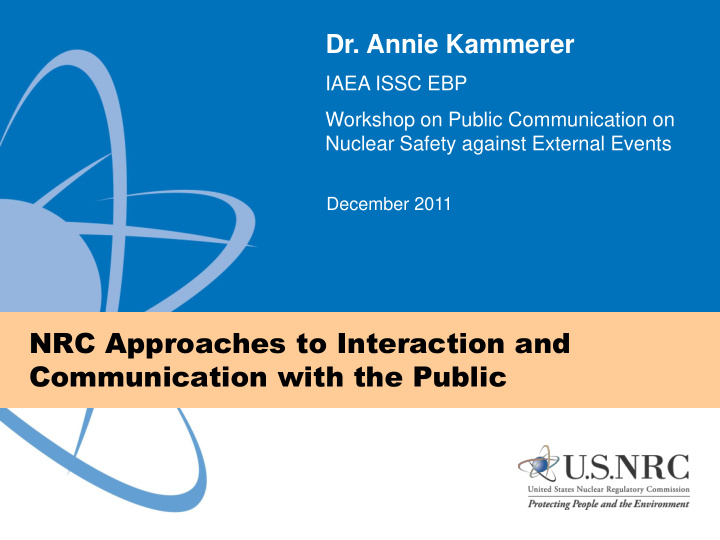



Dr. Annie Kammerer IAEA ISSC EBP Workshop on Public Communication on Nuclear Safety against External Events December 2011 NRC Approaches to Interaction and Communication with the Public
• The NRC continually works toward openness, transparency and good communication • Opportunities for public input exist throughout licensing and relicensing processes • All NRC decisions must follow process and have a clear and justifiable technical basis • NRC staff must provide all information used to make technical decisions and allow independent confirmatory analysis and technical challenge • A willingness to accept criticism is necessary • The public must be treated with respect • As a result, the NRC is generally trusted Key Elements
• US Government “sunshine” laws and the Freedom of Information Act (FOIA) • Many public meetings annually • Regulatory hearings in which the public has right to bring challenge in licensing decisions • Processes for the public to bring issues to the NRC at any time • Public announcements and press releases • NRC Website • Public reading rooms and ADAMS document system make all documents available Principal Avenues for Interaction
• In November 2008 a new fault was found offshore the Diablo Canyon Power Plant (DCPP) through a joint USGS-PG&E research program • Early in 2009 NRC issued a document detailing an deterministic analysis called Research Information Letter (RIL 09-001) • RIL 09-001 described the NRC assessment in full detail so that another expert could replicate the work • It was written to be readable by the public • After issuance, a public meeting was held where anyone could ask questions or pose challenges • The RIL is now being updated with new information Case Study: Diablo Canyon
• Generally 2 to 4 public meetings a year are held near DCPP on different topics • September 2010 there was a 2 day NRC public workshop on seismic hazard and design issues • Day 1-General topics on seismology and hazard • Day 2-Seismic design and risk at DCPP • November SSHAC Level 3 workshop 1 was by PG&E and open to public • 3 day entirely technical meeting on “Data needs and critical issues • The 2010 workshop was to educate interested public in advance of the SSHAC study Case Study: Diablo Canyon
• Public has responded well to: • High quality of the presentations and presenters • Honest communication and technical dialogue • Discussion of uncertainty and discussion of areas in which data gaps occur • Efforts to provide some basic introduction to the topics such that they can follow the discussions • Opportunity at the end of each day for the public to ask questions and make comments (a few political comments were made, but most were technical in nature and were an honest attempt to understand the technical subjects) Case Study: Diablo Canyon
• Public has responded well to: • Post Fukushima response & Near Term Task Force report (ADAMS number ML111861807) • Honest and open self-assessment of needed improvements in NRC approaches and regulations • Ongoing project for reassessment of hazard and risk for all NPPs (Generic Issue-199) • As a result, there has not been a strong reaction in the US, even after the Virginia earthquake • However, the NRC is under additional scrutiny now and appropriate questions are being asked by the public and the government Reaction to Fukushima
• The general concepts of hazard and risk are understood in the US, although details for application to nuclear plants can be confusing • Most Americans accept risk as a fact of life, but expect risk from nuclear plants to be kept very low (essentially zero) • Approach to communicating hazard and risk in the US is to put the science in front and to explain the concepts in simple terms as much as possible • Underlying assumption that people are intelligent enough to understand if we make effort to be clear • Comparisons of dose to other forms of radiation (e.g., flying overseas) are helpful many times Communicating Hazard and Risk
Thank You NRC Approaches to Interaction and Title Goes Here Communication with the Public
Recommend
More recommend